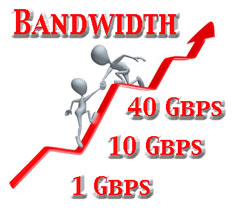Metropolitan and wide area networks are getting faster. Undersea cables are moving from 10 to 40 and even 100 Gbps, and land-based fiber lines are already at 100 Gbps. This means large companies, healthcare organizations, and video producers are starting to find their networks inadequate. The good news is that there are more affordable options than ever before.
There are several practical ways to boost your MAN or WAN bandwidth beyond one Gigabit per second, up to 10 Gbps. Let’s explore the possibilities with SONET, Ethernet, Wavelength, and Dark Fiber.
SONET, which stands for Synchronous Optical NETwork, is a fiber optic standard developed by Bell Labs for the telephone industry. Initially used for carrying massive volumes of phone calls between switching centers, it has evolved to transport data as well. Currently, voice traffic represents a smaller portion of its load.
True to its name, SONET is a precisely timed system that divides data into fixed-size units for transmission. It operates on specific service levels, called Optical Carrier (OC) levels. The most common starting point is OC-3 at 155 Mbps, followed by OC-12 at 622 Mbps.
The next level, OC-24, reaches 1.24 Gbps, but OC-48 at 2.5 Gbps is more widely used. OC-48 is becoming the standard for organizations requiring high-speed private lines or dedicated internet. OC-192 offers 10 Gigabit service at 9.95 Gbps, and beyond that lies OC-768 at 40 Gbps, a speed usually found in carrier backbones and not typically needed by corporations.
SONET service levels have considerable gaps. While OC-48 at 2.5 Gbps is suitable for a 2 Gbps requirement, a 3 Gbps need would necessitate an upgrade to OC-192 at 10 Gbps. Sometimes, a throttled OC-48 connection, offering only the required bandwidth, might be available at a slightly lower cost. However, since OC-48 is standard and fractional services are customized, the savings might not be substantial.
Carrier Ethernet offers more scalability than SONET. While it has standard levels like 100 Mbps Fast Ethernet, 1 Gbps Gigabit Ethernet, and 10 Gbps 10 GigE, providers often allow incremental scaling within the port’s capacity. A 10 GigE port can easily accommodate 3 Gbps, 9 Gbps, or anything in between. Designed for flexibility, Ethernet allows for quick and mostly automated adjustments to service levels, often within hours or days, without equipment changes.
For applications demanding high performance and minimal delay, Wavelength services are a solution. Dense Wavelength Division Multiplexing (DWDM) divides the fiber optic laser into multiple wavelengths, each acting as an independent private line. These wavelengths don’t interact, ensuring dedicated and exclusive traffic flow. Common speeds include 1 GigE, 2.5 Gbps, 10 Gbps, 10 GigE, and 40 Gbps. Notably, both SONET and Ethernet protocols can operate over individual wavelengths.
Dark Fiber provides the ultimate control. Essentially a raw fiber optic strand between two points, it allows you to run any protocol at any speed across multiple wavelengths. The bandwidth potential is vast, but it comes with the responsibility of purchasing, installing, and maintaining the necessary transmission equipment.
If your needs are approaching 10 Gigabit bandwidth, multiple carriers are ready to compete for your business. Request competitive quotes for Gigabit and 10 Gigabit fiber optic services and you might be surprised by the affordability of these high-bandwidth options.


